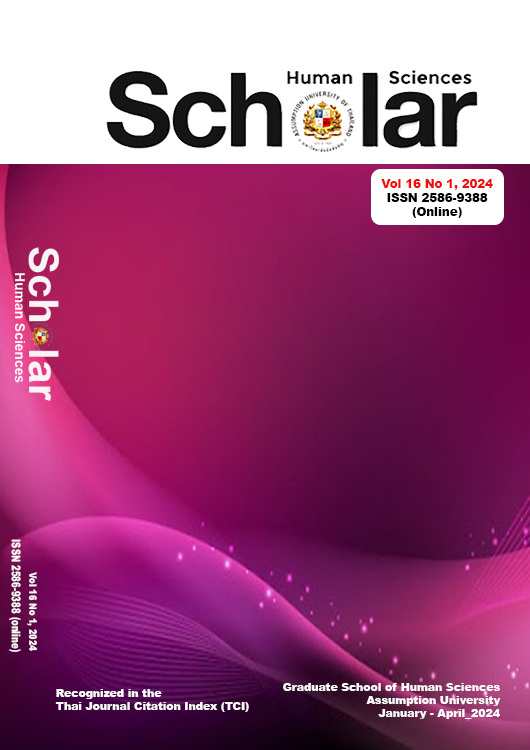The Future of Work and the Impact of Automation on Jobs in Gig Economy in Thailand: A Review of Literature
DOI:
https://doi.org/10.14456/shserj.2024.9Keywords:
Future of Work, Automation, Gig Economy, ThailandAbstract
Purpose: This article aims to analyze the diverse factors that exert a substantial impact on Thailand's gig economy. The factors encompassed in this discussion comprise the potential ramifications of automation, the emergence of novel employment prospects, and the significance of education, labor, and collaboration between industry and academia. Methodology: The authors systematically organized the data to identify patterns, with an emphasis on automation, job creation, and education-industry collaboration. The authors investigated the potential impact of automation on the gig economy, the possibility of job displacement and the need for workers to develop new skills, as well as the chance of new employment opportunities in emerging industries and sectors that require human skills and creativity. Major findings: Patterns and trends indicate that automation influences Thailand's freelance economy. Due to its inherent flexibility and independence, an increasing number of people are opting for contract work. In addition, success in this discipline requires self-motivation, creativity, problem-solving, and evaluation skills. Workers and human resource administrators are able to effectively manage the numerous opportunities and challenges presented due to their proactive adaptation. This procedure optimizes efficiency and cost savings, which in turn drives the expansion of automation. Despite the fact that technology and automation may appear to eliminate occupations, gig laborers still require human skills and self-motivation.
References
Agrawal, A., Gans, J., & Goldfarb, A. (2018). Prediction machines: The simple economics of artificial intelligence. Harvard Business Press.
Ahmed, F., Fattani, M. T., Ali, S. R., & Enam, R. N. (2022). Strengthening the bridge between academic and the industry through the academia-industry collaboration plan design Model. Frontiers in Psychology, 13(875940), 1-11. https://doi.org/10.3389/fpsyg.2022.875940
Australian Bureau of Statistics. (2019, December 9). Characteristics of Employment, Australia, August 2018 to August 2019. Australian Government. https://www.abs.gov.au/statistics/labour/employment-and-unemployment/characteristics-employment-australia/latest-release
Brynjolfsson, E., & McAfee, A. (2014). The second machine age: Work, progress, and prosperity in a time of brilliant technologies. W. W. Norton & Company.
Bughin, J., & Manyika, J. (2016). Independent work: Choice, necessity, and the gig economy. McKinsey Global Institute.
Bulian, L. (2021). The gig is up: who does gig economy actually benefit?. Interdisciplinary Description of Complex Systems, 19(1), 106-119.
Bureau of Labor Statistics. (2018, June 7). Contingent and Alternative Employment Arrangements – May 2017. U.S. Department of Labor. https://www.bls.gov/news.release/pdf/conemp.pdf
Bureau of Labor Statistics. (2023, April 25). Arts, Design, Entertainment, Sports, and Media Occupations. Occupational Outlook Handbook. https://www.bls.gov/ooh/arts-and-design/home.htm
Burtch, G., Carnahan, S., & Greenwood, B. N. (2018). Can you gig it? An empirical examination of the gig economy and entrepreneurial entry. Management Science, 64(12), 5497-5520.
Frey, C. B., & Osborne, M. A. (2017). The future of employment: How susceptible are jobs to computerisation? Technological Forecasting and Social Change, 114, 254-280.
Hong, S., & Shell, H. G. (2018). The impact of automation on inequality. Economic Synopses, 29, 1-2.
Horton, J., Kerr, W. R., & Stanton, C. (2017). Digital labor markets and global talent flows. Working paper 17-096. Harvard Business School.
International Federation of Robotics (IFR). (2019, September 18). World Robotics 2019.
https://ifr.org/downloads/press2018/Executive%20Summary%20WR%202019%20Industrial%20Robots.pdf
International Labour Organization. (2022, January 17). World employment and social outlook: trends 2022. International Labour Office. Geneva.
International Renewable Energy Agency. (2020). Renewable Energy and Jobs – Annual Review 2020. https://www.irena.org/publications/2020/Jun/Renewable-energy-and-jobs-Annual-review-2020
Kelliher, C., & Anderson, D. (2008). Doing more with less? Flexible working practices and the intensification of work. Human Relations, 63(1), 83-106.
Kuek, S. C., Paradi-Guilford, C., Fayomi, T., Imaizumi, S., & Ipeirotis, P. G. (2015). The global opportunity in online outsourcing. McKinsey Global Institute. https://econpapers.repec.org/paper/wbkwboper/22284.htm
Li, L. (2022). Reskilling and upskilling the future-ready workforce for industry 4.0 and beyond. Information System Frontiers. https://doi.org/10.1007/s10796-022-10308-y
Manyika, J., Chui, M., Miremadi, M., Bughin, J., George, K., Willmott, P., & Dewhurst, M. (2017). A future that works: automation, employment and productivity. McKinsey Global Institute. https://www.mckinsey.com/~/media/mckinsey/featured%20insights/Digital%20Disruption/Harnessing%20automation%20for%20a%20future%20that%20works/MGI-A-future-that-works-Full-report.ashx
McKinsey Global Institute. (2017, December). Jobs lost, jobs gained: What the future of work will mean for jobs, skills, and wages. https://www.mckinsey.com/featured-insights/future-of-work/jobs-lost-jobs-gained-what-the-future-of-work-will-mean-for-jobs-skills-and-wages
Mieruch, Y., & McFarlane, D. (2022). Gig economy riders on social media in Thailand: contested identities and emergent civil society organizations. Nature Public Health Emergency Collection, 30, 1-11.
Ministry of Internal Affairs and Communications. (2018, June). Report on Survey of Labor Force Status (Basic Tabulation): June 2018. Japanese Government. https://www.stat.go.jp/english/data/roudou/report/index.html
Office for National Statistics. (2018, October 16). Employment in the UK: October 2017 to September 2018. UK Government. https://www.ons.gov.uk/employmentandlabourmarket/peopleinwork/employmentandemployeetypes/bulletins/employmentintheuk/previousReleases
PwC. (2017, June 22). AI Impact Index. https://www.pwc.com/gx/en/issues/data-and-analytics/artificial-intelligence/ai-impact-index.html
Roy, G., & Shrivastava, A. (2020). Future of Gig Economy. Opportunities and Challenges, 9(1), 14-25.
Sargeant, M. (2017). The gig economy and the future of work. E-Journal of International and Comparative Labour Studies, 6(2), 1-18.
Thailand Board of Investment. (2016). Thailand’s automation & robotics. https://www.boi.go.th/upload/content/BOI-brochure%202016-automation-20170615_14073.pdf
Umar, M., Xu, Y., & Sikandar, M. S. (2020). Impact of Covid-19 on Gig Economy. Ekonomska Istraživanja / Economic Research, 34(8), 1-15.
Vinayan, G., Harikirishanan, D., & Ling, S. M. (2020). Upskilling and reskilling the workforce via industry driven technical and vocational education and training: strategies to initiate industry/institution partnership in Malaysia. Journal of Economic Info, 7(2), 94-103.
Wood, A. J., Graham, M., Lehdonvirta, V., & Hjorth, I. (2019). Networked but commodified: the (dis) embeddedness of digital labour in the gig economy. Sociology, 53(5), 931-950.
World Economic Forum. (2020, October 20). The Future of Jobs Report 2020. https://www.weforum.org/reports/the-future-of-jobs-report-2020/




